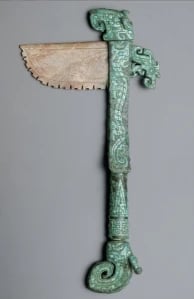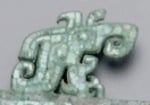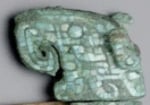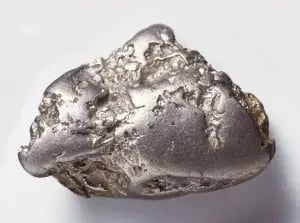Wealth or War
“Military valor is often paired with civil virtue.” Chinese Art and Culture, p.64
Virtue is, then, attributed to the owner of an opulent prize, legitimizing his honor and authority. We must ask ourselves, however, is a lavish weapon, merely a weapon of wealth or an actual tool of war? The ceremonial dagger-axe, ge (Figure 2-7), of the Shang period, (circa 1200-1050 BCE), is a deluxe specimen of bronze weaponry. It measures 13.5 inches (34.5cm) and is now housed at the Freer Gallery of Art of the Smithsonian Institution in Washington D.C. During the ancient Chinese Bronze Age, the ge was commonly used for “hacking and stabbing” in warfare (64). Thousands have been uncovered, but few possess special features that suggest prestige, chiefly rank or warrior status. This particularly rare piece, however, is more obviously a work for aesthetic appreciation, rather than functional service. Its elaborate surface perforations and inlay design render the dagger too fragile to withstand vigorous use either as a tool or in combat (64).


Resembling a mosaic, the hilt of this ceremonial axe divides into three principal orders of decoration. The bottom curls into itself in a tail-like fashion. An arrow design on the thinner handle then guides our attention upward. Atop the weapon, the central partition portrays the elongated, undulating form of a serpent or dragon. Next, finials, at its high point and flanking the haft, resemble birds with curved beaks, inset circular eyes, plumage and flattened horns. The dense surface of the greenish-blue semiprecious stone juxtaposes with the more basic white jade. Mounted at a right angle on the shaft, the nephrite blade, browned by the effects of time and the elements, has been meticulously carved with double-incised, coiled, cloud-like lines. Sharp frets, or flanges, protrude from the bottom margin, functioning as the sharp edge of the weapon. The bronze instrument, adorned with ample turquoise inlay and a jade blade, was unquestionably a “token of status” (64).
Its careful, detailed treatment was believed to evoke the power of nature. The early precedents of qi energy formations appear in the abstracted cloudlike, curling forms on the jade plane. These patterns embody the constant mutability of moving matter, that is, spiritual space that possesses mass, according to the claims of the later Qin and Han dynasties (c. 221-220 BCE) (25). In addition, zoomorphic motifs manifest themselves in the form of a dragon-like serpent or bird. Animals and fantastic creatures were believed to harness communicative powers, allowing shamans of this world to connect with deceased ancestors. The shamans would channel energy through the animals. Birds, in particular, were believed to be the voices of omens. Perhaps here, then, the animals serve as posthumous guides.
Grave goods of personal ornaments, found in tombs, served as forms of ancestral veneration, as well as indexes of social complexity and economic organization. Buried with their owners, these goods were status symbols and signs of wealth. These crafts also possessed a virtue of durability, not only because of their materials, but also because they had a better chance of survival underground. Therefore, it may be that this relic was consigned to the tomb of an individual belonging to the royal or elite echelon of society. The Shang king himself was known to be a powerful martial figure, and this axe was found in Yinxu, the “ruins of the Yin,” which was the traditional location of the last Shang capital. Shang kings regularly fought statelets or chiefdoms on their borders. It is therefore possible that this piece belonged to the Shang leader himself.
In order to comprehend the effect this piece may have had on a common, Shang dynasty audience, an explanation of ancient bronze practices is imperative. Bronze casting for military purposes was a major industry. This extensive operation was not generally available, as society’s economic base was controlled by the king. "Ore sources had to be found and mined. Laborers smelted raw ore into metal ingots that were then transported to foundries. Potters adept at model and mold making, and at firing up kilns to heat alloy, needed their own raw materials and fuel. The casting process itself required specific expertise so that the melt could be properly mixed, the pour carefully controlled, the furnace closely monitored. Final cold working (filing, polishing) to finish objects imposed its own requirements of skill" (68-69). Requiring control over precious resources, casting technology, and a skilled, specialized labor force, coordination of the entire creative process was exacting. By consequence, a differential distribution of wealth becomes clear (34).
Full appreciation of the weapon requires an intimate knowledge of the materials used and the expert handling invested. Astounding is that so much information about the social workings of ancient China--its hierarchy, military practices, belief system, craftsmanship--can be extrapolated from one art object. Exemplary both of the relic’s ritualistic potential and its lavish display of wealth, the exceptional representation of metalwork was an unmistakable object of admiration, recognized as awe-inspiring, delicate and not to be handled.
Works Cited:
Smithsonion Freer Gallery of Art and Arthur M. Sackler Gallery. "Dagger Axe (Ge)."2009. Freer + Sackler Galleries. 25 April 2009.
Thorp, Robert L. and Richard Ellis Vinograd. Chinese Art & Culture. Ed. KaraHattersley-Smith. Upper Saddle River: Pearson Education, Inc., 2006.








